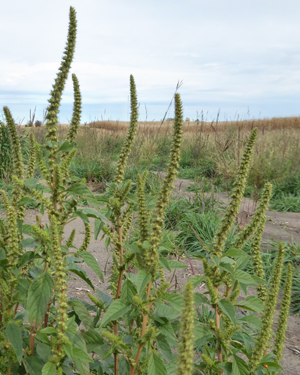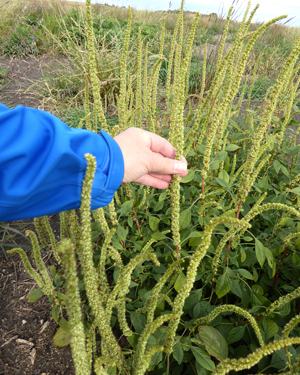 In September 2016, Palmer amaranth, Amaranthus palmeri, was found in Minnesota. To date, it has been documented in the counties on the linked map. The Minnesota Department of Agriculture (MDA), University of Minnesota Extension, U.S. Department of Agriculture (USDA), landowners and other partners are working to eradicate these infestations before they can spread to new areas.
In September 2016, Palmer amaranth, Amaranthus palmeri, was found in Minnesota. To date, it has been documented in the counties on the linked map. The Minnesota Department of Agriculture (MDA), University of Minnesota Extension, U.S. Department of Agriculture (USDA), landowners and other partners are working to eradicate these infestations before they can spread to new areas.
Why the concern?
Palmer amaranth is a fast growing weed native to the southwestern United States and northwestern Mexico, and has spread east and north. It has developed resistance to multiple classes of herbicides and their different modes of action, making it very difficult and expensive to control. Palmer amaranth is a prolific seed producer. Up to 500,000 seeds can come from one plant. It is also highly competitive.
It has a fast growth rate of two to three inches per day and commonly reaches heights of six to eight feet, greatly inhibiting crop growth. Reported yield losses have been up to 91 percent in corn and 79 percent in soybean in some states. The weed can also significantly increase production costs for corn, soybean, and other crops.
What is the weed's legal status in Minnesota?
Since 2014, Palmer amaranth has been listed on Minnesota’s Prohibited Noxious Weed Eradicate List. All above and below ground parts of the plant must be destroyed. Additionally, no transportation, propagation, or sale of this plant is allowed. Failure to comply may result in enforcement action by the county or local municipality. Find more info on noxious weeds.
In November 2016, the Commissioner of Agriculture listed Palmer amaranth as a Prohibited Weed Seed in agricultural, vegetable, flower, tree, shrub, native grass, and forb seeds sold in Minnesota. Any seed lot contaminated with Palmer amaranth is not legal for sale in Minnesota. To properly label a seed lot, the noxious exam must include genetic testing to determine whether any Amaranthus seed found may be identified as Palmer amaranth. Visit the MDA's Seed Program website for more information on seed regulations in Minnesota.
What can you do?
Be proactive and prevent Palmer amaranth establishment. Familiarize yourself with Palmer amaranth identification and actively look for it in crop fields, borders, ditches, conservation lands and around dairies. Contact MDA's Weed Team, U of M Extension Crops Educator, or your crop consultant to learn more about identifying Palmer amaranth.
If you suspect Palmer amaranth on your property, immediately visit the MDA's Report A Pest page and enter the location of the suspected plants and your contact information into our online reporting form or download our mobile app. Once you've reported through Report A Pest, an MDA staff member will contact you for more information. If a suspect plant is found, please save it until the species has been confirmed. Live plant material should be placed in a plastic bag and refrigerated. Dead and dry plant material should be placed in a paper bag and stored at room temperature. Click on the Report a Pest icon to go directly to the Report a Pest webpage.
AVOID entering areas where Palmer is suspected or confirmed. If you must enter an infested area, always clean vehicles, equipment, and clothing prior to exiting.
If planting grasses and other flower mixes for conservation plantings, carefully review the seed label to ensure that no noxious weeds are present. If you are concerned, contact the Seed Regulatory Program at the MDA at 651-201-6531 for label review and sampling. Reputable seed sources will also be able to supply seed testing results for their seed mixes.
How can you identify Palmer amaranth?

- Palmer amaranth is a summer annual that commonly reaches heights of six to eight feet but, can reach ten feet or more.
- The green leaves are smooth and arranged in an alternate pattern that grows symmetrically around the stem. The leaves are oval to diamond or triangle shaped.
- The leaves of some Palmer amaranth plants have a whitish V-shaped mark on them. Not all Palmer amaranth plants display this characteristic.
- There are separate male and female plants.
- Palmer amaranth looks similar to our native pigweeds such as tall waterhemp (A. tuberculatus), Powell's amaranth (A. powellii) and redroot and smooth pigweeds (A. retroflexus and A. hybridus respectively). Here are some distinguishing characteristics:
- Redroot and smooth pigweeds have fine hairs on their stems and leaves. Palmer amaranth and waterhemp do not have these hairs.
- The petiole (stalk connecting a leaf to the stem) is longer than the length of the leaf. For tall waterhemp, the petiole will be only half the length of the leaf.
- Seedhead spikes on female Palmer amaranth plants are much taller (up to three feet long) and more prickly than waterhemp or redroot and smooth pigweed spikes.
- Genetic tests are available to confirm visual confirmation. Contact the MDA for labs offering this service.


